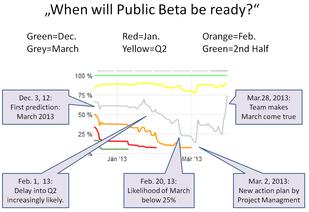Wiki article
Compare versions Edit![]()
by Hubertus Hofkirchner -- Vienna, 04 Oct 2013
As information technology is becoming more and more strategic in the age of the internet, companies are increasingly impacted by their ability to finish IT projects on time. Delays will domino into consequential damages for the entire company. But it seems almost fated that the vast majority of IT projects will be delayed. Worse, about a quarter of all IT projects are cancelled before completion. Clearly, a lot of money is at stake here. Is there really no way to improve things?
The Experiment

In an experiment, we wanted to see what happens if we complement the standard IT project management methods with an innovative use of the social web: Instead of asking project members only to input the estimates of their portion of the project, we asked all of them also to estimate the overall project duration, including the parts for which others were responsible.
In the venerable tradition of self-experimentation, we tried this with the very software we are developing ourselves: we used the alpha version of Prediki to predict when its beta version would be ready. For a bit of excitement, we threw in some prize money and made it into a contest.
The results were astounding. The overall “top-down” consensus prediction not only beat our traditional project management “bottom-up” GANTT plan, which would have been off by a factor of 2. It was almost spot on.
Where’s the Magic?
In hindsight, several factors contributed to this success.
- First, everybody had a say in the original estimate. Later it turned out that this translates into team buy-in as the majority of project members had an interest in the agreed outcome and put in an extra effort to make the prediction come true.
- Second, everybody could change their prediction at any time. And project members did, not least to improve their chances in the contest.
- Third, team members also saw that management would listen to what they say, as every change in the prediction was charted like a share price on a stock exchange.
Tangible results
In summary, top management got a highly responsive 24/7 monitoring system and had more peace of mind from a real-time view on total timeliness. When several tasks ran into problems, project steering could react much faster to get them back on track.
And last but not least, the company had an IT project which actually finished right on time.
A Final Word of Caution
“Management by Predictions” did not mean that we neglected or abandoned our existing project management methods. Prediction markets work best when as much information as possible is captured and aggregated. A diverse group of participants contributing many different angles and viewpoints is crucial.
The ROI of method stems from reducing the forecast error and consequential damages versus traditional methods, from a real-time feedback channel for management, and from the motivational benefits for the team.
